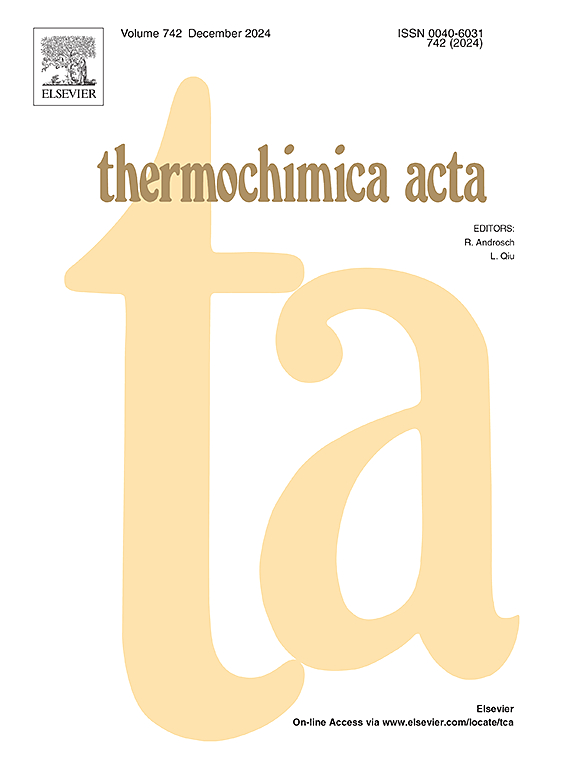Exploring the thermal transformations of glucosamine-functionalized graphene oxide aimed at controlled fabrication of polycrystalline ceramic-graphene composites
IF 3.1
2区 化学
Q2 CHEMISTRY, ANALYTICAL
引用次数: 0
Abstract
Graphene oxide is commonly used as a precursor to graphene in ceramic-matrix composites, as it can be thermally reduced to reduced graphene oxide (r-GO) at much lower temperatures than those required for sintering of the ceramic materials. In wet forming methods, dispersibility of graphene oxide in aqueous medium can be enhanced through surface modification. In this study, thermogravimetry and differential thermal analysis coupled to mass spectrometry (TG/DTA-MS) were applied to analyze the thermal transformations of glucosamine-functionalized graphene oxide (GO) compared to non-functionalized GO, both of which are key components in the fabrication of ceramic-graphene composites. Measurements were conducted under two different atmospheres: air and argon, to assess the influence of oxidative and inert environments on thermal stability and decomposition processes. Mass spectrometry (MS) enabled the identification of gaseous by-products released during decomposition. The combined TG/DTA-MS technique provided valuable insights into the thermal stability, volatile emissions, and potential environmental impact of the analyzed samples. The paper also describes the advances in thermal analysis, showing the wide range of programming possibilities and sample loading. This integrated approach is essential for optimizing the sintering process of composite materials, exemplified by ZrO₂-graphene composites. Additionally, the paper highlights several applications of TG-MS in ceramics manufacturing, including additive manufacturing and colloidal processing. The different possibilities of measurement data processing are also presented.

探索氨基功能化氧化石墨烯的热转化,以控制制备多晶陶瓷-石墨烯复合材料
氧化石墨烯通常用作陶瓷基复合材料中石墨烯的前驱体,因为它可以在比陶瓷材料烧结所需的温度低得多的温度下热还原为还原性氧化石墨烯(r-GO)。在湿成型方法中,通过表面改性可以提高氧化石墨烯在水介质中的分散性。在本研究中,采用热重法和差热分析耦合质谱法(TG/DTA-MS)分析了氨基功能化氧化石墨烯(GO)与非功能化氧化石墨烯(GO)的热转化,两者都是制备陶瓷-石墨烯复合材料的关键成分。测量在两种不同的气氛下进行:空气和氩气,以评估氧化和惰性环境对热稳定性和分解过程的影响。质谱法(MS)能够鉴定分解过程中释放的气态副产物。TG/DTA-MS联合技术为分析样品的热稳定性、挥发性排放和潜在的环境影响提供了有价值的见解。本文还介绍了热分析的进展,显示了广泛的编程可能性和样品加载。这种集成方法对于优化复合材料的烧结工艺至关重要,例如ZrO₂-石墨烯复合材料。此外,本文还重点介绍了TG-MS在陶瓷制造中的几种应用,包括增材制造和胶体加工。还介绍了测量数据处理的不同可能性。
本文章由计算机程序翻译,如有差异,请以英文原文为准。
求助全文
约1分钟内获得全文
求助全文
来源期刊

Thermochimica Acta
化学-分析化学
CiteScore
6.50
自引率
8.60%
发文量
210
审稿时长
40 days
期刊介绍:
Thermochimica Acta publishes original research contributions covering all aspects of thermoanalytical and calorimetric methods and their application to experimental chemistry, physics, biology and engineering. The journal aims to span the whole range from fundamental research to practical application.
The journal focuses on the research that advances physical and analytical science of thermal phenomena. Therefore, the manuscripts are expected to provide important insights into the thermal phenomena studied or to propose significant improvements of analytical or computational techniques employed in thermal studies. Manuscripts that report the results of routine thermal measurements are not suitable for publication in Thermochimica Acta.
The journal particularly welcomes papers from newly emerging areas as well as from the traditional strength areas:
- New and improved instrumentation and methods
- Thermal properties and behavior of materials
- Kinetics of thermally stimulated processes
 求助内容:
求助内容: 应助结果提醒方式:
应助结果提醒方式:


